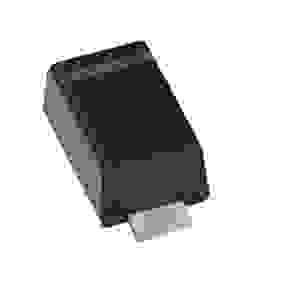Switching diode is an electronic device that utilizes the unidirectional conductivity of semiconductors to achieve circuit on/off control. Its classification methods are diverse, and the following analysis is presented in a logically clear manner from four dimensions: material, structure, characteristics, and packaging form

1、 Classified by material
Silicon-based switch diode
Characteristics: Using silicon (Si) as the semiconductor material, it has high withstand voltage, low reverse leakage current, and good temperature stability.
Application scenarios: Widely used in consumer electronics, communication equipment, industrial control and other fields, such as power switches and signal detection.
Germanium based switching diode
Characteristics: Using germanium (Ge) as a semiconductor material, it was widely used in the early days, but gradually replaced by silicon-based devices due to material characteristics such as high reverse leakage current and poor temperature stability.
Application scenario: limited to specific retro circuits or teaching experiments.
Compound semiconductor switch diode
Types: such as silicon carbide (SiC), gallium nitride (GaN), etc.
Features: Capable of working at high frequencies, high voltages, and high temperatures, with switching speeds up to GHz level.
Application scenarios: High end fields such as 5G communication, satellite communication, and electric vehicle charging modules.
2、 Classified by structure
Point contact switch diode
Structural characteristics: PN junction is formed by contacting metal filaments with the semiconductor surface.
Features: Extremely small capacitance, high switching speed, but low current capacity.
Application scenarios: High frequency detection, mixing, and small signal switching circuits.
Surface contact switch diode
Structural features: PN junction has a large area and high current capacity.
Features: Low on resistance, high withstand voltage, but slow switching speed.
Application scenarios: High current scenarios such as power rectification and continuous current protection.
Flat switching diode
Structural features: Made using flat technology, high integration, suitable for large-scale production.
Features: High parameter consistency and small size.
Application scenarios: Integrated circuits, surface mount components (SMD).
3、 Classified by Characteristics
High speed switching diode
Key parameter: The reverse recovery time (TRR) is extremely short (usually<10ns).
Features: Extremely fast switching speed, suitable for high-frequency pulse circuits.
Application scenarios: Radio frequency (RF) circuits, digital logic gates, pulse generators.
High reverse voltage withstand switch diode
Key parameters: High reverse breakdown voltage (VR) (up to several thousand volts).
Features: Able to withstand high voltage environments, low reverse leakage current.
Application scenarios: High voltage side switch of power supply, lightning arrester, electrostatic protection.
Low reverse leakage current switch diode
Key parameter: extremely low reverse leakage current (IR) (usually<1 μ A).
Characteristics: Suitable for precision circuits sensitive to leakage current.
Application scenarios: sample and hold circuits, low-noise amplifiers, precision detectors.
4、 Classified by packaging form
Plug in packaged switch diode
Types: such as Axial Lead package and Glass package (DO-35).
Features: The pins pass through the PCB board, and the soldering is reliable, but the volume is relatively large.
Application scenario: Traditional through-hole installation circuits, such as household appliances and instruments.
Surface mount packaged switch diode
Types: such as SOT-23, SOD-123, SOD-323.
Features: Small size, suitable for automated surface mount production, low parasitic inductance.
Application scenarios: portable devices, high-density integrated circuits.
Special packaged switch diode
Types: such as power module packaging, array packaging.
Features: Integrate multiple diodes or combine with other devices (such as MOSFETs) to increase power density.
Application scenarios: Electric vehicle motor controllers, industrial frequency converters.
5、 Application areas and selection considerations
Communication equipment: High speed switch diodes (such as SiC based) are preferred to cope with high-frequency signals.
Consumer electronics: Surface mount packaging (such as SOT-23) has become mainstream due to its small size and low cost.
Industrial control: High reverse withstand voltage switch diodes (such as VR>1000V) can ensure system reliability.
Automotive electronics: AEC-Q101 certification is required, with priority given to wide temperature range (-55 ℃~175 ℃) devices.
6、 Development Trends
Material innovation: Wide bandgap semiconductor materials such as silicon carbide and gallium nitride are gradually becoming popular, promoting the development of switching diodes towards high frequency, high voltage, and high temperature.
Structural optimization: Technologies such as trench type structures and super junction structures further reduce on resistance and switching losses.
Integration: Single chip integration with MOSFET, IGBT and other devices to form power modules and simplify circuit design.
The classification system of switch diodes covers multiple dimensions such as materials, structures, characteristics, and packaging forms. In actual selection, factors such as operating frequency, withstand voltage, current capacity, packaging size, and cost need to be comprehensively considered. For example, in 5G communication base stations, gallium nitride based high-speed switching diodes have become the preferred choice due to their GHz level switching speed; In electric vehicle motor controllers, silicon carbide based high reverse voltage withstand switch diodes are widely used due to their high voltage bearing capacity. With the continuous advancement of technology, the classification of switching diodes will be more refined to meet the demand for high-performance power devices in different fields.
